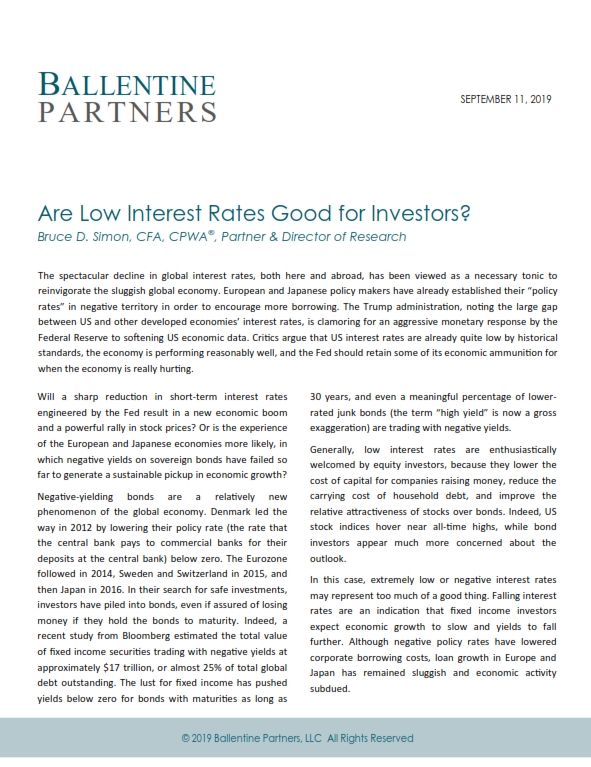The spectacular decline in global interest rates, both here and abroad, has been viewed as a necessary tonic to reinvigorate the sluggish global economy. European and Japanese policy makers have already established their “policy rates” in negative territory in order to encourage more borrowing. The Trump administration, noting the large gap between US and other developed economies’ interest rates, is clamoring for an aggressive monetary response by the Federal Reserve to softening US economic data. Critics argue that US interest rates are already quite low by historical standards, the economy is performing reasonably well, and the Fed should retain some of its economic ammunition for when the economy is really hurting.
Will a sharp reduction in short-term interest rates engineered by the Fed result in a new economic boom and a powerful rally in stock prices? Or is the experience of the European and Japanese economies more likely, in which negative yields on sovereign bonds have failed so far to generate a sustainable pickup in economic growth?
Negative-yielding bonds are a relatively new phenomenon of the global economy. Denmark led the way in 2012 by lowering their policy rate (the rate that the central bank pays to commercial banks for their deposits at the central bank) below zero. The Eurozone followed in 2014, Sweden and Switzerland in 2015, and then Japan in 2016. In their search for safe investments, investors have piled into bonds, even if assured of losing money if they hold the bonds to maturity. Indeed, a recent study from Bloomberg estimated the total value of fixed income securities trading with negative yields at approximately $17 trillion, or almost 25% of total global debt outstanding. The lust for fixed income has pushed yields below zero for bonds with maturities as long as 30 years, and even a meaningful percentage of lower-rated junk bonds (the term “high yield” is now a gross exaggeration) are trading with negative yields.
Generally, low interest rates are enthusiastically welcomed by equity investors, because they lower the cost of capital for companies raising money, reduce the carrying cost of household debt, and improve the relative attractiveness of stocks over bonds. Indeed, US stock indices hover near all-time highs, while bond investors appear much more concerned about the outlook.
In this case, extremely low or negative interest rates may represent too much of a good thing. Falling interest rates are an indication that fixed income investors expect economic growth to slow and yields to fall further. Although negative policy rates have lowered corporate borrowing costs, loan growth in Europe and Japan has remained sluggish and economic activity subdued.
Importantly, very low fixed income yields create a number of undesirable consequences as well. These include: 1) pressure on bank profitability and insurance companies’ ability to meet long-term obligations; 2) a notable preference for companies to increase share buybacks and dividends instead of expanding capital expenditures (a signal of their lack of confidence in the economy despite nearly “free” money); 3) for companies that are making investments, the cheap borrowing costs improve the economic viability of marginal deals, sowing the seeds for problems down the road; and 4) the huge penalty on savers hoping to at least maintain purchasing power with their cash. In addition, if and when interest rates do begin to rise again, the cost of servicing all this debt will become an increasing burden for borrowers.
Investors are counting on the Fed to sharply reduce short-term interest rates to boost a slowing but still growing US economy. But with the 10 year US treasury already yielding a historically low 1.60%, would lower rates generate a big boost in spending on new plants and equipment? While the thought of aggressive policy easing from the Fed may rekindle animal spirits for risk assets in the short-run, the longer-term benefits may be less positive. In that case, investors should be careful what they wish for.
Learn more about Bruce Simon, our Director of Research.

This report is the confidential work product of Ballentine Partners. Unauthorized distribution of this material is strictly prohibited.
The information in this report is deemed to be reliable but has not been independently verified. Some of the conclusions in this report are intended to be generalizations. The specific circumstances of an individual’s situation may require advice that is different from that reflected in this report. Furthermore, the advice reflected in this report is based on our opinion, and our opinion may change as new information becomes available.
Nothing in this presentation should be construed as an offer to sell or a solicitation of an offer to buy any securities. You should read the prospectus or offering memo before making any investment. You are solely responsible for any decision to invest in a private offering.
The investment recommendations contained in this document may not prove to be profitable, and the actual performance of any investment may not be as favorable as the expectations that are expressed in this document. There is no guarantee that the past performance of any investment will continue in the future.




